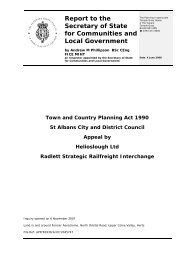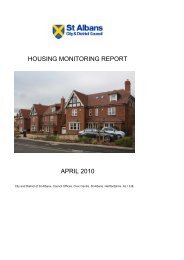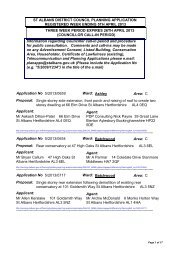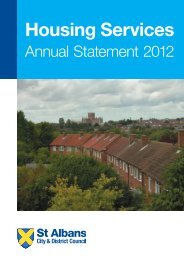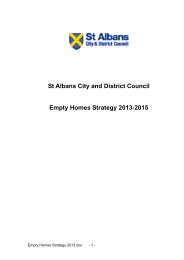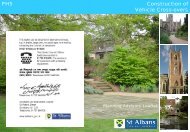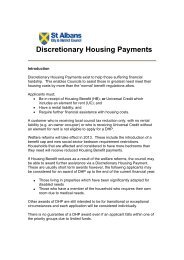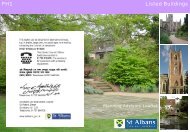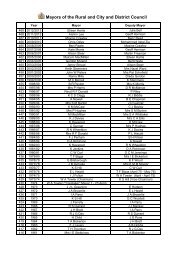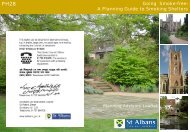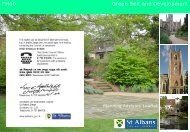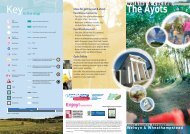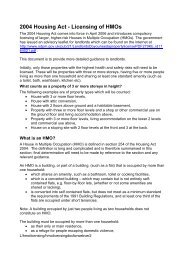14 October 2011 - St Albans City & District Council
14 October 2011 - St Albans City & District Council
14 October 2011 - St Albans City & District Council
Create successful ePaper yourself
Turn your PDF publications into a flip-book with our unique Google optimized e-Paper software.
New Matters and Changes in Circumstances: Rail Freight<br />
4.5 The <strong>2011</strong> RUS acknowledges major operational constraints for routing freight along<br />
the MML in Table 9.8 (included as Appendix B to this report):<br />
I<br />
I<br />
I<br />
“Interaction with intensive Thameslink service north of Carlton Road junction<br />
on the MML”;<br />
“Restrictions on loading gauge with 3 gauge-constrained tunnels, and numerous<br />
bridges, between Carlton Road junction and Bedford”; and<br />
“significant infrastructure enhancement costs involved to enable efficient<br />
carrying of 9’6” international shipping containers on conventional wagons.”<br />
4.6 The RUS <strong>2011</strong> states that “some opportunities for using the MML south section<br />
(Carlton Road Junction – Bedford) will continue to be available following the<br />
completion of the Thameslink programme, with two trains per hour freight paths<br />
anticipated by the RUS in each off peak standard hour. However many of these<br />
paths are likely to be taken up by existing domestic traffic (for example<br />
aggregates), so options for London Gateway growth would be extremely limited,<br />
even if this were the preferred routing to the North.” (Paragraph 9.5.12). The<br />
available existing freight paths are 60% utilised at present and future growth in<br />
aggregate traffic (see section 6 below) could increase utilisation of the existing off<br />
peak freight paths to 75%.<br />
4.7 In addition, the RUS concludes that given the gauge constraints on the MML, and<br />
the extremely high cost and disruption caused by their resolution (above all in the<br />
Kentish Town/Carlton Road area), an alternative routing for freight trains would<br />
be appropriate:<br />
‘Whilst there are potentially smaller scale opportunities to provide additional or<br />
higher speed crossovers [on the MML] to reduce to a limited degree the<br />
interaction between MML freight and Thameslink services this is not sufficient to<br />
change the conclusion that an alternative routing strategy, generally involving<br />
the WCML, is preferred.” (Paragraph 9.5.12).<br />
4.8 The statement contained in the quotation above clearly establishes that the prime<br />
freight route to the Midlands, the north of England and Scotland is the WCML. This<br />
is because its gauge is appropriate to the type of traffic (9’6” containers); it has<br />
good connections to a variety of routes to and from the ports; it is electrified; and<br />
freight terminals have been developed close to the WCML.<br />
4.9 The RUS is fully consistent with the emerging picture of freight paths following the<br />
opening of the proposed HS2 to the West Midlands, in that the WCML has the<br />
necessary gauge and capacity to accommodate the expected traffic in line with<br />
the commercial aspirations of freight operators and freight services continue to be<br />
will be concentrated on the WCML. The MML will continue its current role of<br />
handling existing domestic freight traffic using the existing 2 trains per hour<br />
freight paths past the Radlett site in each off peak hour which is compatible with<br />
the future Thameslink service.<br />
4.10 The RUS includes formal publication, for the first time (Table 5.2 and included as<br />
Appendix C to this report) of the indicative services for Thameslink in 2018 with 24<br />
trains per hour through the core Central London section in the peak periods, and<br />
16 trains per hour on the MML past the Radlett site. At the time of the Inquiry,<br />
only an “indicative picture of their [Thameslink] aspirations” was available in<br />
3



